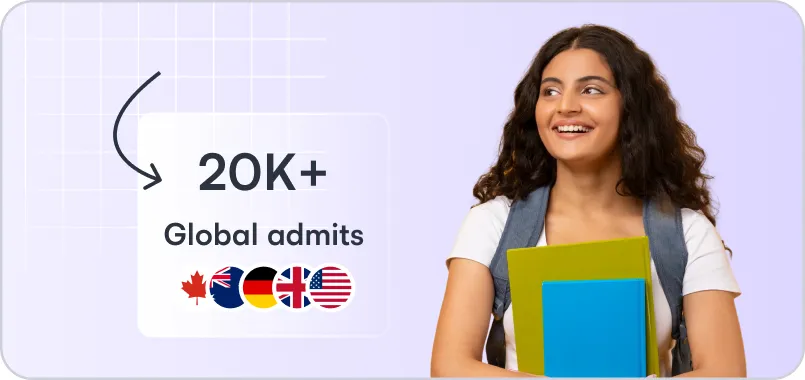The sheer joy of receiving an admit is coupled with the realisation that most students require additional funding (beyond savings and family support) to cover the Cost of Attendance (CoA) for a masters programme abroad which could stretch up to two years.
Your best bet is to start as early as you can - and this 7-stage timeline will guide you through each step.
- Post-application stage (October to January)
-
Admissions consultants typically advise on applying to about 10 schools, with a mix of dream, realistic and safe schools. That means you’ll spend a lot of time working on the various Statement of Purpose (SoP) essays and letters of recommendation. But, once you’re done with that, it’s a good time to start looking at your loan options.
-
As Prodigy Finance’s loan application process is 100% online, free of cost and takes only 30 minutes, it’s easy to create multiple online applications - one for each supported school. There’s no documentation required at this stage; this provisional offer is non-binding (and your loan can’t be completed without your admit letters).
-
You’ll receive an almost instant conditional loan offer (customised for each school and programme) containing the loan amount, interest rate and repayment period. Loan amounts may vary, providing you with extra data to make your final school choice if (and when) you receive multiple admits.
-
- Post-admit stage (February to April)
-
Whether you receive multiple admits or a single one, this is the deadline for comparing loan offers.
-
Depending on your situation, that could be comparisons between loans from the same lender across schools or offers for the same school across lenders.
-
Annual Percentage Rate (APR) is the easiest tool for comparing loan offers as long as the loan repayment period is the same across loans.
-
TIP: Indian banks and Non-Banking Financial Corporations (NBFCs) are not mandated by the Reserve Bank of India (RBI) to reveal the APR on loans. However, you can exercise your right to request APR from potential lenders to enable comparison.
-
Prodigy Finance discloses the APR and has a transparent loan repayments calculator on it’s website, enabling borrowers to effectively compare loan offers and make an informed decision on which loan offer works best for each individual.
-
If you choose to go with a Prodigy Finance loan, you’ll move into the verification stage which means uploading copies of the required documents.
-
Within ten working days, Prodigy Finance will verify that your documents match the data provided during the application stage. On successful verification, the provisional offer becomes a confirmed offer and Prodigy Finance issues a free loan letter for your selected school and programme.
-
- I-20 form and visa application stage (May to June)
-
If you’re headed to the US, you’ll need to make certain that any potential lender’s loan letter will suffice for both I-20 and visa purposes. (Students pursuing international degrees elsewhere in the world will need to check the loan letter meets the needs for the relevant visa processing.)
-
TIP: Some NBFC lenders charge a fee of 1% of the loan amount to issue loan sanction letters – this hidden fee may result in a higher APR on your loan. Be sure to check on this fees and any others that might be attached to your account.
-
The loan letter from Prodigy Finance is free of charge - you can simply print a hard copy and take it along to your visa interview.
-
- Pre-departure stage (July to August)
-
Once you’ve secured your visa, it’s time to explore the value-added benefits provided by your lender. Both NBFCs and international lenders offer student discounts on housing, telecommunications and more. But, you may need to ask what’s available.
-
In addition to the housing and cell phone discounts, Prodigy Finance also offers 11 annual scholarships worth US $10,000 each, as well as career support when you need it most.
-
- Campus arrival stage (August to September)
-
It’s time to make sure the necessary funds are disbursed to your school.
-
Some lenders will transfer your loan to your account: you’ll be responsible for transferring your tuition fees to the university before the due date.
-
TIP: If your loan is disbursed to you in a currency that’s different than the one used by your university, you’ll need to account for currency conversion fees. When this happens, you’ll need to count these costs towards the total APR of your loan.
-
Prodigy Finance disburses your loan directly to the university – it’s a direct transfer in US dollars so there aren’t delays, late payment fees or currency conversion costs. You’ll just need to sign your final loan agreement when you arrive on campus to finalise your loan so the funds can be disbursed.
-
- Study and grace period stage (September onwards)
-
Lenders usually provide some form of moratorium during your studies, and typically an additional six month grace period after classes end.
-
TIP: Some domestic banks and NBFCs expect payment of interest during this period – which is normally furnished by the co-signer (as student often don’t have an income while studying). And, some NBFCs don’t permit pre-payments during the first six months of study, and restrict pre-payments to three times a year thereafter.
-
Prodigy Finance does not impose any pre-payment penalties, so borrowers are free to make early repayments, higher than required payments or even close their account by paying the entire outstanding loan amount at any point after the first disbursement.
-
- Repayments stage
-
After your grace period ends, you’ll need to begin repayments. In some cases, these are known as Equal Monthly Instalments (EMIs), but your lender may call them something else. Either way, your monthly statement will disclose the exact amount to be repaid.
-
With Prodigy Finance, repayment is in the same currency of the loan (USD) – this proves convenient as most international MS graduates remain in the US to work for at least three years on an Optional Practical Training (OPT) visa.
-
Given the global economy we live in, it’s equally possible that masters graduates may end up working in another geography outside their country of origin or country of study. Prodigy Finance offers online repayment in 200 global currencies, enabling graduates to repay USD, GBP or EUR loans in a choice of currencies.
-
Have more questions? Want to learn more about Prodigy Finance loans?
While these seven stages provide you with a solid overview, it’s up to you to take the next step. Why not start by applying for Prodigy Finance loans for your shortlisted programmes. Apply for a Prodigy Finance loan now.
This article is a part of Prodigy Finance's FinLit series of webinars and blog articles. Read the rest of the articles here:
- Prodigy Finance Answers your Top 10 Education-Loan Questions
- Education loan 101: Understanding International Loan Terms
- What's Annual Percentage Rate for Education Loan & 9 other FAQs
- True cost of an Education Loan
- The 7 stages of your International education loan
- Applying for MS? Understand your education loan options...before you even apply to your school
Get your overseas education funded. Get a loan quote under 20 mins today!


